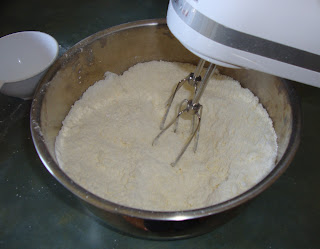I had looked for a long time and had tried several other recipes (with varying degrees of failure), before finding this one. It has a nice flavor and rises nicely. The amount of flour can vary significantly with each batch. Each time that I have made it, I have used a different amount of flour; from 2 to 2 ½ cups.
Basic Pizza Dough
3/4 C. Warm Water or Flat Beer (105-115°F)
4 tsp. Sugar
1 Tbsp. Olive Oil
1/2 tsp. Salt
1 tsp. Active Dry Yeast
2 to 2 1/4 C. Bread Flour
Heat water in microwave until temperature reaches 105-115°F. (If the water is too hot, it will kill the yeast). Sprinkle the yeast onto the surface of the water and stir in until dissolved. Add sugar and stir in a teaspoon of flour; set aside for 5 minutes. The mixture should begin to bubble. If the mixture doesn't bubble, either the yeast is too old or the temperature of the water was too hot and you should start over again with fresh yeast or cooler water.
After the yeast begins to bubble, add it to the remaining ingredients in the bowl of an electric mixer (or other large bowl). Knead on low speed for 15 minutes or turn out onto a clean work surface which has been dusted lightly with flour and knead for the same amount of time.
The dough should feel slightly sticky when you are done kneading, but it shouldn't cling to your hands. If it does, knead in a few dustings of flour. If the dough doesn't feel slightly sticky, there's not enough moisture; knead in a few drops of water.
Tip: To hydrate the dough just a little, soak a paper towel with water and wrap it lightly over the dough ball and leave it to rest for 5 minutes, then knead the extra moisture into the dough.
Exact measurements for the quantities of flour and water are never accurate since one batch of flour will absorb more or less water than another based upon storage and harvesting methods, age of flour and the type of wheat, the way in which the flour is milled, the weather, and a number of other conditions. Each time the dough is prepared is unique, but experience will teach you the proper consistency.
When the dough is smooth and elastic it is ready to begin the rising phase.
Place a few drops of olive oil at the bottom of a large heavy bowl. Place the rounded dough ball in the bowl and turn to coat the mass lightly with oil; this prevents the dough from forming a crust which would keep it from rising fully. Cover the bowl with plastic wrap or a clean, damp cotton towel and place in a warm place, free from draft. (Inside an oven, on top of a refrigerator or hot water heater are good spots if they are draft-free).
Allow the dough to rise, undisturbed until it has nearly doubled in bulk. This can take 60-90 minutes, depending on the yeast and room temperature.
At this point, the dough may be punched down (deflated - the air bubbles pressed out) and stretched to form a pizza crust and used immediately (or it may be sealed tightly in freezer bags and frozen for later use; defrost in microwave for 5-7 minutes or allow to sit at room temperature for 1-2 hours before using).
When ready to bake, set the baking rack in the oven to the lower or lower-middle rack and set the oven temperature to 475°F. Allow oven to preheat for at least 20 minutes. If available, a pizza stone may be set in the oven for a crisper crust.
While the oven preheats, stretch (don't roll) the dough out to a 14 inch diameter circle (or much wider if you prefer even thinner pizza crusts). The dough may be pressed out on a work surface and transferred to an ungreased pan (sprinkle a little cornmeal or semolina flour into the pan to prevent sticking, or spray lightly with olive oil spray). Another method is to press the dough directly into the pan. Or if you're feeling adventurous, stretch the dough out by holding it over the backs of two upheld hands, turning and allowing the dough's weight and gravity to stretch it out (they use a variation of this method in pizza shops to make the famous "hand stretched" dough).
Top with preferred toppings, such as sliced fresh peppers, mushrooms, onions, pepperoni, anchovies, cooked Italian sausage, etc. Sprinkle with a few hot red pepper flakes (according to taste) and salt and pepper. Feel free to experiment with toppings of your choice, varying the quantity and type of sauce or cheese. You may also brush the crust with garlic butter to add some additional flavor.
Bake for approximately 15 minutes or until crust is golden brown.
Source: Cooks.com
































